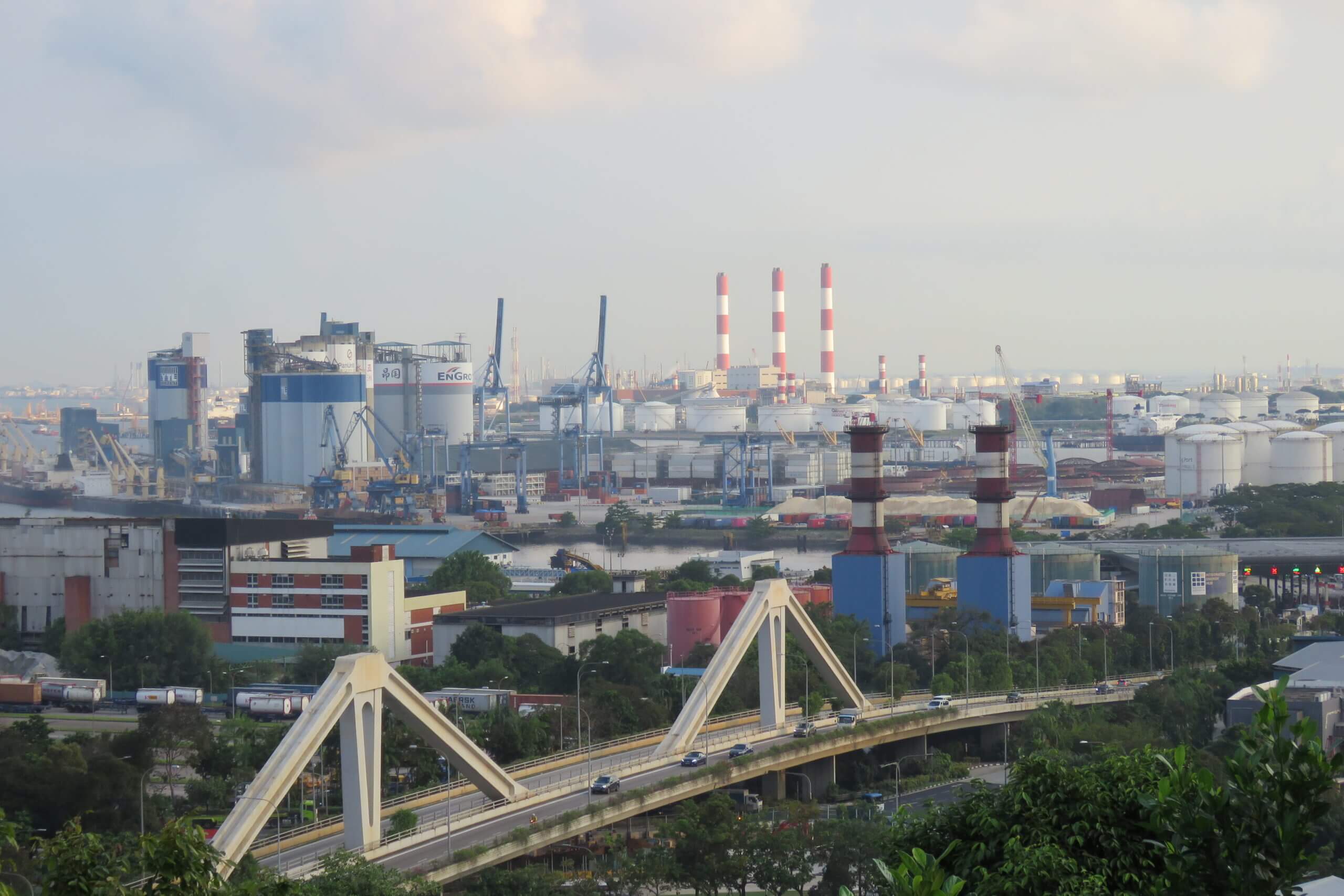New research by CARES published in Energy & Environmental Science proposes an economically viable, versatile and renewable solution for CO2 emissions reduction in the chemical industry.

Singapore’s Jurong Island.
To avoid environmentally and economically devastating climate breakdown, quick action to reduce greenhouse gas emissions that contribute to global heating is essential. However, the dependence of the world economy on products derived from fossil fuels is a major obstacle, hindering our progress towards an emissions-free future.
At present, the chemical industry is responsible for around 15% of industrial carbon dioxide (CO2) emissions. For as long as economies continue to depend on fossil fuels, these emissions will remain a harmful by-product. As we wait for renewable energy technologies to become adopted more widely, what if we could make use of these emissions instead of allowing them to continue polluting the atmosphere?
CARES researchers have proposed a new, onsite CO2 recycling technology that could take the waste CO2 from chemical production processes and turn it into other chemicals that go straight back in to the production unit. Furthermore, this technology does not require new plants and factories to be built – it can be retrofitted into existing chemical plants, thus not competing with mature methods for bulk chemicals production.
The recycling concept is based on the use of an electroreduction reactor, where CO2 is converted to useful chemicals, e.g. ethylene. Although this technology can be applied to any plant that produces CO2, using concentrated CO2 streams is most economically viable so that costly procedures are not required to separate CO2 out from flue gas streams. For this reason, the researchers have chosen a chemical production process where such a concentrated CO2 stream is already available: ethylene oxide (EO) manufacturing. Currently, EO plants frequently vent this pollutant stream to the atmosphere, and the proposed technology enables conversion to ethylene instead. This bulk chemical is used as raw material for production of ethylene oxide, meaning that the products of CO2 electrolysis can be used directly at the same plant, minimising both the direct CO2 emissions and the requirement for petrochemical feedstocks.
As a key raw material for ethylene glycol manufacturing, as well as a common disinfectant, EO is widely used and always in demand, making EO production an excellent market to showcase the benefits of CO2 recycling.

Proposed pathway for CO2 recycling (R4) within EO manufacture (R1)–(R3).
In order for such a technology to be viable for a chemical company, it must meet three criteria: a significant reduction of CO2 emissions, a short payback time and no change in the production scale of the chemical. CO2 recycling using electroreduction fulfils these requirements, with low operational costs and minimal disruption to existing manufacturing processes.
Running the recycling process on renewable energy, such as wind or solar, would lead to significant emissions reduction. Operating entirely with a waste stream product, CO2 recycling has the flexibility to run while intermittent renewable energy is available, with small-scale storage solutions in place. If the renewable energy is only partially integrated into the grid mix, the process can still make a significant impact on CO2 emissions and reduce the need for non-renewable feedstocks.
This work has positive implications for Singapore as it aims to meet its Paris Agreement pledge of reducing its emissions by 36% from 2005 levels by 2030. Singapore’s chemical industry is a vital part of its economy, employing over 25,000 people and ensuring Singapore’s place in the top 10 chemical exporters worldwide.[1]
The paper’s authors Dr Magda Barecka, Professor Joel Ager and Professor Alexei Lapkin are part of CARES’ eCO2EP project, which aims to develop ways to transform CO2 emitted as part of the industrial process into compounds that are useful in the chemical industry supply chain. eCO2EP is one of several projects hosted by the Cambridge Centre for Advanced Research and Education in Singapore (Cambridge CARES).
Dr Barecka, lead author on the paper, said “This technology is exciting due to the huge impact it can make at a very low cost and with a simple retrofit for existing chemical plants. Furthermore, if renewable energy is used, we could reduce direct CO2 emissions by up to 80% in each plant. There is so much potential for emissions reduction across the board and we are looking forward to seeing the technology start to make a difference.”
“Economically viable CO2 electroreduction embedded within ethylene oxide manufacturing” (DOI: 10.1039/D0EE03310C) is published in Energy & Environmental Science by researchers from Cambridge Centre for Advanced Research and Education in Singapore Ltd, University of Cambridge and University of California, Berkeley.
About CREATE
This research is supported by the National Research Foundation, Prime Minister’s Office, Singapore, under its Campus for Research Excellence and Technological Enterprise (CREATE) programme. CREATE is an international collaboratory housing research centres set up by top universities. At CREATE, researchers from diverse disciplines and backgrounds work closely together to perform cutting-edge research in strategic areas of interest, for translation into practical applications leading to positive economic and societal outcomes for Singapore. The interdisciplinary research centres at CREATE focus on four areas of interdisciplinary thematic areas of research, namely human systems, energy systems, environmental systems and urban systems.
[1] https://www.edb.gov.sg/en/our-industries/energy-and-chemicals.html. Data from 2015.


